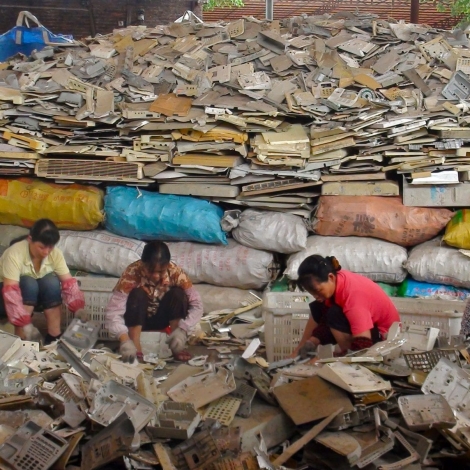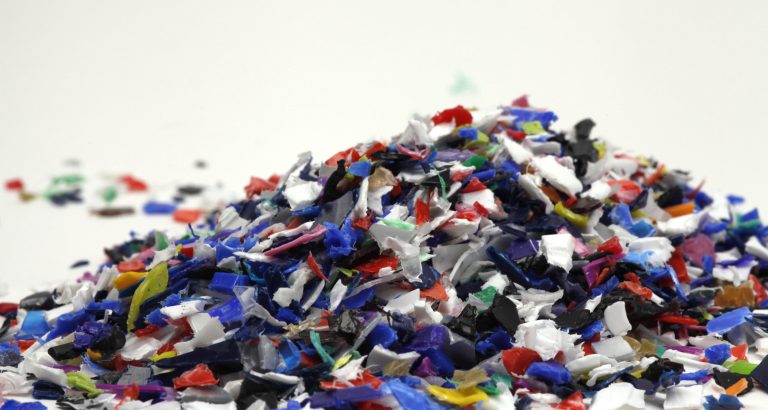Countries that once imported plastic waste to recycle are no longer accepting shipments, forcing the polluting nations to process their own trash. The scope of the plastic problem is enormous, and solutions will require new policies, new products and new packaging.
Microplastics: A Macro Problem
Plastics production has outpaced almost all other manufactured materials; as of 2017, a cumulative 8.3 billion metric tons (MT) of plastic was produced and only nine percent of all generated plastic waste has been recycled.
Ultimately, it’s time for the United States and other nations to confront their waste and make a change.
Beyond waste accumulation in landfills, plastic deposits in the environment cause numerous problems including chemical leaching and wildlife entanglement, and there is particular concern about the incidence of microplastics. These small plastic fragments (less than 5 mm long) are increasingly prevalent, and an area of burgeoning public and environmental health research.
In 2010 alone, an estimated 4.8 to 12.7 million MT of plastics entered the ocean. According to the Ocean Conservancy, 8 of the top 10 contributors to marine trash are single-use plastics.
Scrapping the Status Quo
Until recently, North Americans and Europeans exported their plastics and the associated processing and pollution concerns. In 2016, China received over 50 percent of the world’s recycled paper and plastic, including over 95 percent of the European Union’s plastic alone.
See also: As More Developing Countries Reject Plastic Waste Exports, Wealthy Nations Seek Solutions at Home
Many of these exports were poor quality and their high contamination levels prompted diplomatic disputes. In Malaysia, for example, “garbage [was] being traded under the pretext of recycling,” says Yeo Bee Yin, Malaysia’s Environment Minister. Malaysia subsequently announced that the government would be sending back 3000 tons of imported plastic. From 2013 to 2014, more than 100 containers arrived in the Philippines marked as recyclable scrap but contained household garbage delivered from a private Canadian company. A 2016 court ruling ordered the company to take back the waste, but as of 2019 the waste remained at the port. President Rodrigo Duterte gave Canada a hard deadline of May 15th to remove the waste. “Let’s quarrel with Canada. I will declare war against them,” Mr. Duterte said. “Load that up on a ship and I will advise Canada that your garbage is on the way. Prepare a grand reception. Eat it if you want to.” When this deadline was missed, President Duterte recalled his country’s ambassador and other diplomats from Canada.
See also: How Can Rural Villages Manage Moutains of Empty Plastic Bottles?
In February 2017, China announced a campaign to stop the smuggling of illegal scrap imports as part of its National Sword policy, followed by the announcement of a complete ban in 2018. As a result of the new Chinese policies alone, an estimated 111 million MT of plastic waste will be displaced by 2030.
Reallocating exports to other countries will not be an effective solution. Over the past year other countries have followed in China’s footsteps: Malaysia and Indonesia announced reductions in plastics-scrap-import licenses, Vietnam a full ban by 2025, Thailand a ban within two years, and India a ban with full implementation by August 2019.
“Garbage was being traded under the pretext of recycling,”- Yeo Bee Yin, Malaysia’s Environment Minister
Municipalities across the United States are struggling to handle their abruptly accumulating bales of plastic. Recycling costs have drastically increased; towns are stockpiling or landfilling plastics, and some recycling facilities have stopped accepting them altogether. The fallout from China National Sword and other recent bans highlights the problem in managing this growing waste stream, and the need for change.
What now?
Solving our global plastic waste problem requires significant technological advancements. Current research focuses on pyrolysis (high-temperature decomposition), repurposing only specific plastic types within the 1-7 resin scale, chemical recycling, and lightweighting product designs, yet these innovations are either insufficient or under-developed. Innovations must be environmentally sustainable, scalable, affordable, and effective. Therefore, as engineers work rapidly to develop solutions, the immediacy of the problem necessitates that governments make complementary waste management reforms.
See also: Emerging Economies Convert Plastic Waste into Fuel
As the United States and other countries who outsourced recycling are forced to confront their own waste, this can be an opportunity for systematic transformation in plastics production and end-use management. Policy shifts are already occurring. A number of cities, states, and countries have announced single-use plastic ban legislation. Other states are exploring Extended Producer Responsibility for plastics packaging, shifting the responsibility for end-of-life management from municipalities to producers.
Ultimately, it’s time for the United States and other nations to confront their waste and make a change. As Environment Minister Yeo Bee Yin said, “When we first discovered this problem in Malaysia, we talked about it as a global problem, and we recognized that we should be a voice for developing countries. If they don’t dump it in my country, they’ll dump it somewhere else. And that has to stop.”

